[slideshow_deploy id=’266′]
Artist, savior, collector, survivor: Caroline Rogers Hill may have been many things in her long life, but boring was not one of them. As a young woman from a middle class family, Hill could not have imagined her future as an artist and collector in Paris. Her life journey evolved through a combination of good fortune and adventurous decisions: from her marriage to a wealthy banker, to her escape from Europe amid the destruction of World War II, to the acquisition of a Duccio masterpiece, Hill took advantage of every opportunity life offered her. Good fortune also befell Mount Holyoke College when Hill donated her varied and valuable art collection, allowing the Art Department to flourish and fostering the development of the museum.
Backstory
Caroline Rogers was born in Boston on August 5, 1878, five weeks before the family of five children moved to New Salem.1 Ten years later, the Rogers family moved again to Barre, where Caroline’s parents, Mr. and Mrs. August Rogers, owned and operated the Barre Gazette.2 For her undergraduate degree, Hill went to Wellesley College. During her time at the small liberal arts college, she did not perform well academically, but made her mark as the coxswain of the crew team.3 After graduating in 1900, Caroline worked at the Wellesley Inn, where she met her future husband, William H. Hill.4 It was through William that Caroline’s Cinderella story would begin.

William Hill was a Boston banker in his 60s and Caroline was 28, the same age as his youngest daughter, when the couple married on April 6, 1906.5 William had already traveled the world before settling in Boston and told Caroline that if she married him, she could do anything she wanted after his death, but while he was alive, she had to care for him at home.6 William had amassed a fortune through banking, his connections with the Eastern Steamship Lines, and local mills.7 With her husband’s money, before his death, Caroline was able to pursue and receive a master’s degree in economics and the philosophy of education from Radcliffe University in 1912.8 Then, on October 14 of the next year, William passed away, leaving his estate to his widow.
The War Years
Hill took her new freedom as a license to travel the world and do good deeds. Her first stop on this trip was France, where she participated in voluntary relief work during World War I. In 1915, Caroline worked for the “Enfants de la Frontière,” a charity that collected and placed children from devastated districts and broken homes into new homes where they would be safe.9 Many years later in a 1950 article in the Barre Gazette about the honors she received for her relief work, Hill recalled in an “interesting experience” from that time: while she was helping to remove Belgian children from the front, “she was asked to be received by the Queen of the Belgians, who was in hiding.”10 During the war, Hill was also in a church that was hit during Big Bertha’s attack on Paris, and narrowly escaped.11 The widow traveled back and forth from Europe to America in order to raise money for her charitable causes, including the Children’s Kit Movement, which clothed over 10,000 children. Hill’s leadership was recognized by the United States Government, which recruited her to personally investigate all French private charities that had requested aid from the Red Cross.12
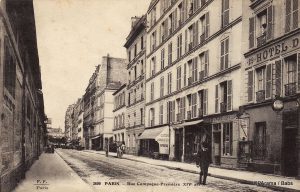
After World War I ended, Caroline stayed in France, continuing her relief work by making five-reel films and taking photographs of children affected by war to use in fundraising campaigns, while also studying art. From 1923-30 she practiced sculpture, and then from 1932 until her death she painted under the tutelage of Antoine Bourdelle and Andre Lhote.13 Hill was not connected with any art institution, but she was able to display her work in galleries in New York City and Paris.14 One of her paintings, seen below, is now at the Phillips Collection. France was an empowering place for liberal, independent women in the 1920s; Hill ran in the same circle as Gertrude Stein and many male and female authors, artists, and poets.15
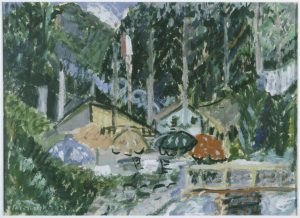
Hill intended to continue her relief work in France during World War II. From March 1940-July 1941, she worked in hospital clinics for the Secours Quaker and represented the American Committee of Funds for France. Her work included obtaining milk for babies, and feeding mothers and children.16 In 1941, Hill’s brother came to Europe to make her leave; he put her on a boat back to the USA right before the war intensified.17 Although no longer in Europe, Caroline was active in the New York Office of American Aid to France, where she planned food and medication shipments and studied under French doctors so that she could pass the entrance examination for the Assistante Sociale de la Libération. The war ended in 1945, and no longer a young woman, Hill returned to Paris, where she continued to work in the Office of American Aid to France. There, she supervised C.A.R.E. packages and organized food distribution to schools. Hill was honored for her work in Europe during both wars with the Medal of Elizabeth and the Reconnaissance Francoise after World War I, and the Legion of Honor, a Blue Ribbon from the Ministry of Education and Population, and the Palms Academique after World War II.18
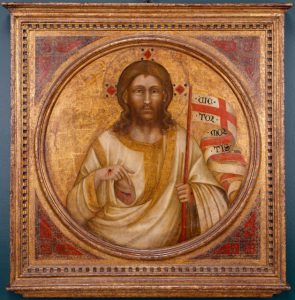
Building a Collection
Between World War I and World War II, Hill began to collect artwork under the advice of famed art scholars Wilhelm von Bode, who worked for museums in Berlin and specialized in medieval art, and Raimond Van Marle, who wrote The Development of the Italian Schools of Painting.19 These two men are responsible for the Italian and medieval flavor of Hill’s collection, but it is not known how or where the group met. Many of the pieces she collected were from antique shops in France and Italy, or from museums. For example, Duccio’s “Angel” from the Maestà altarpiece, one of the most valuable pieces in the collection, was acquired when the Kaiser Friedrich Museum in Berlin deaccessioned it in the 1920s.20 Hill also purchased a number of contemporary drawings, along with medieval architectural fragments, medieval paintings, ancient Roman artifacts, and 15th – 17th century Dutch paintings. Some of the outliers in the collection include a Chinese vase and a 18th-19th century candelabra, which, according to a family member, she had in her bedroom at her house in Manchester-by-the-Sea.21
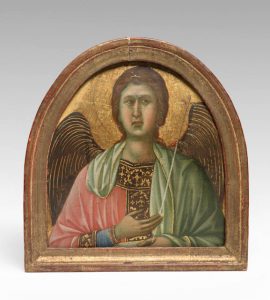
The Hill collection was first exhibited at Wellesley College in the 1920s; however, the number of pieces exhibited there is not known. Caroline donated three pieces to the Wellesley Art Museum at this time: an Italian Romanesque capital with confronting lions from Parma, a Sienese medieval painting, “Saint John the Baptist” (thought to be from Duccio’s studio), and a Roman bust of a child. In 1922, there was discussion among Wellesley museum staff of possible further gifts, but for some reason her collection moved to the Currier Gallery of Art in Manchester, New Hampshire in the 1920s.22 Then, in the 1930s, it was again moved to the Springfield Museum of Art, where it was displayed and then stored until a new gallery was found.23
[slideshow_deploy id=’205′]
Hill continued painting and traveling after World War II, but found herself in debt because she had lost parts of her French estate in the war. The director of the Springfield Museum of Fine Arts, Frederick B. Robinson, arranged to have her art collection advertised for sale.24 It is not clear how the chair of Mount Holyoke College’s Art Department, Marian Hayes, heard about the opportunity, but in 1951, Robinson wrote to Hayes to tell her that Caroline Hill had responded “yes” to her letter, and that Mount Holyoke College would receive the Hill collection on indefinite loan.25 Why she did not later give the art to Wellesley as indicated in earlier correspondence with her alma mater is unclear, but, based upon reading each college’s correspondences with Hill, the Mount Holyoke Art Department staff seemed more gracious and friendly with her than that of Wellesley, which possibly accounts for the rejection of her alma mater. Furthermore, in her Wellesley College Alumnae Association registration form in 1941, Hill wrote that she had “hoped [she] would aid in forming new art collection – not successful.”26 This suggests that there was a falling out of sorts between Hill and Wellesley College years before she loaned everything to Mount Holyoke. Each year from 1951 until 1957, she donated one or two pieces of her collection to the college.
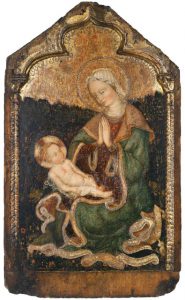
Despite her dire financial situation, in 1957, Hill rejected an opportunity to sell pieces of her art. On October 25, her art dealer wrote to her regarding interest in her “Italian Primitives” (Italian artworks from the 14th, 15th, and 16th centuries), to which she replied, “Dear Mr. Castano, In reply to your letter of Oct. 25, I have withdrawn the collection of Italian Primitives from the market, and extended the loan to Mt. Holyoke. I am sorry to disappoint your clients and you. The college is making such excellent use of the collection as a whole that it would be a pity to break it up, or withdraw it.”27

In 1960, Hill donated three pieces to Wellesley, two contemporary French paintings and a bust, but this is trivial compared with the 80 paintings, sculptures, and material culture objects acquired by Mount Holyoke.28 Such a massive donation to a school other than her alma mater begs the question, why?
Caroline and Mount Holyoke College
Hill actively communicated with both Marian Hayes and Dorothy Cogswell, who succeeded Hayes as Chairman of the Art Department when she retired. The relationship between Hayes and Hill in the 1950s could be described as formal yet friendly. The women corresponded regularly after the Hill collection came to the college; the earliest letters between the two mainly discuss insurance policies and transportation, and preservation efforts the museum was making. In particular, some of the medieval paintings Caroline had donated were buckling in the middle, so Mr. Jakstas, the restoration specialist, placed humidifiers in front of the works in the Dwight Art Museum, where they were first displayed.29 Care of Hill’s art was discussed extensively, and she requested many photos to be taken of her objects on display and mailed to her, with which Hayes complied.

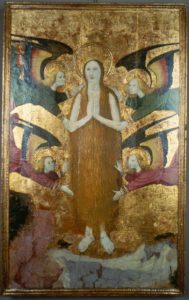
It is not clear how the Hill Collection made its way from Europe to the United States, but in addition to the Springfield Museum of Fine Arts, part of the collection ended up at Hill’s brother’s house in Manchester, New Hampshire. The Pompeiian wall paintings were among the objects there, and were brought to Mount Holyoke in an art department staff member’s van in the 1950s.30 Because Hill had acquired so much of her collection from antique shops, there was very little provenance information. In 1952, Hayes inquired about any information Caroline might have, only to be disappointed by the lack thereof. It is believed that any information that may have existed was burned by a family member, possibly Donald Hill, who had power of attorney over his aunt’s estate.31 This lack of information led to false assumptions about work in the collection, which were later corrected by Professor and Mrs. D Talbot Rice (Professor Talbot Rice was a Byzantinist and professor of art at the University of Edinburgh), and Mount Holyoke faculty. For example, the Pompeian fresco was believed to portray a “shepherd boy,” which is now known to be Bacchus.32
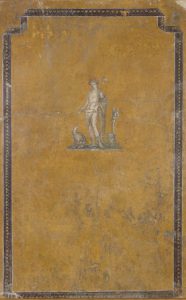
In 1952, Hayes wrote to Hill about how her class on Italian art utilized the collection. The professor described how her students were able to study from real artifacts for the first time, and how this excited them. Hayes believed that Caroline would have loved to hear the students’ reports, as can be seen in the below letter. Even Mount Holyoke’s president, Richard Glenn Gettell, wrote to Hill to thank her for her wonderful gift and wrote again after every subsequent donation to the college.
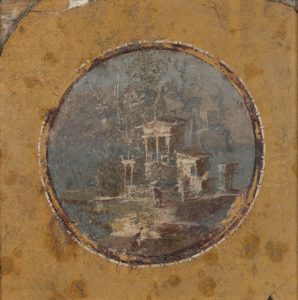
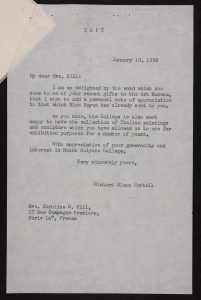
Before the arrival of the Hill Collection, the majority of works in Dwight Art Museum were plaster casts or archaeological artifacts. In 1963, Cogswell rejected Hill’s proposed gift of plaster casts to the museum because they were in the process of removing them from the collection.33 Plaster casts did not allow students to interact with fine art in the way the Hill Collection did; for example, one student, Penelope Hayes, researched the manner in which Duccio painted halos.34 Prior to Hill’s donation, students would have only used photographs or plaster casts to research, hindering their ability to perform close-looking analysis. Marian Hayes describes the new teaching and learning style as “a wonderful stimulus… Even in the short time we have had the paintings, the girls have developed a very genuine interest them and I think they have opened up a whole new field of study for these students.”35 Through Hayes and Cogswell’s art history classes, the emerging discipline of art history was truly able to flourish at Mount Holyoke; Caroline Hill’s gift of fine art ushered the college into a new era of teaching art.
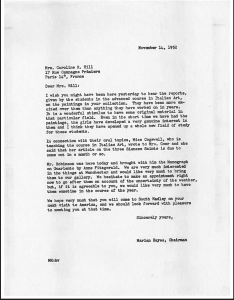
By 1957, Hill had decided to give her entire collection to Mount Holyoke. Between 1957 and 1961, Hayes and Hill developed a closer relationship, corresponding about family, art, and their travels. In 1960, Caroline traveled to Mexico and stopped in South Hadley to meet with students and faculty to discuss the art before returning to Europe.36 After Cogswell took Hayes’ place as chair in 1961, she became friends with Hill as well. Cogswell specialized in medieval art, and her classes made much use of the Hill Collection.37 Cogswell continued the casual correspondence with Caroline and her nephew Donald, who helped with administrative paperwork, continuously inviting the pair to visit Mount Holyoke and linking students who were studying abroad in France with Hill. By the 1960s, the depth of the Wellesley alumna’s connection with Mount Holyoke made it seem almost as if she was an honorary Mount Holyoke alumna.38
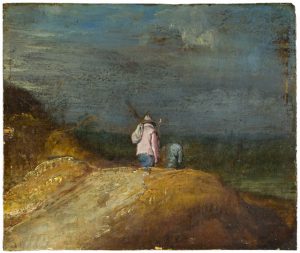
In 1963, the Mount Holyoke College Art Museum invited Hill to join their first Advisory Committee. It is unclear if she did become a member, but she did not receive the letter in time to attend the initiation event. She wrote back that she would accept the position if “no particular effort is required.”39. In her final years, Caroline struggled with arthritis, so, unable to paint, she travelled the world. She visited Guatemala and Arizona in 1964 before passing away in Cuernavaca, Mexico on March 1, 1965 at the age of 86. In her will, the entire Hill Collection was left to Mount Holyoke. In 1971, the newly built Art Building became the home of the Mount Holyoke College Art Museum, moving Caroline’s art to a new home, the Hill Gallery.40 The naming of the gallery after Caroline Rogers Hill was a tribute to an incredible woman’s dedication to the arts through times of hardship and her transformative gift to the college.
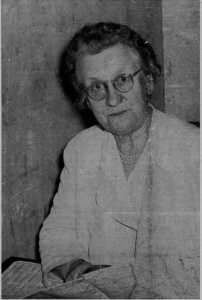
Timeline
1878
Born August 5, in Boston.
1900
Graduated from Wellesley College.
1906
Married William Hill on April 6.
1912
Received Master’s degree from Radcliffe.
1913
William Hill died.
1915
Began relief work in France.
1920s
Began actively collecting, bought Duccio’s Angel.
Collection exhibited at Wellesley College.
Sculpted.
Collection moved to Currier Gallery of Art.
1930
Collection moved to Springfield Museum of Fine Arts.
1932
Began studying painting.
1940-1
Participated in relief war during World War II.
1941
Returned to the United States.
1945
Returned to France.
1951
Mount Holyoke College acquired Hill Collection on indefinite loan.
1957
Hill decided to give entire collection to Mount Holyoke College.
1960
Visited Mount Holyoke College and Mexico.
1963
Hill is offered a position on the Mount Holyoke College Art Museum Advisory Board.
1964
Travelled to Guatemala and Arizona.
1965
Died Cuernavaca, Mexico on March 1, 1965.
Works Cited
Hall, Nicholas H.J., “Jacques Goudstikker – Dealer and Connoisseur,” November 14, 2007, http://www.christies.com/special_sites/goudstikker_part3/articles.asp?a=1, viewed November 26, 2016.
Kowza, Irene. “Former Barre Woman Active in Relief Work in Foreign Lands.” The Barre Gazette. August 3, 1950, from Caroline Rogers Hill files, Wellesley College Archives, Wellesley, MA.
Mount Holyoke College Art Museum, Donor Files, “Caroline Rogers Hill,” Folders 1, 2, South Hadley, MA.
Schmidt-Scheuber, Victoria, “A History of the Mount Holyoke College Art Museum,” November 16, 2011, https://www.mtholyoke.edu/org/artgoddesses/more%20articles/MHCAM%20135%20Retrospective.html, viewed December 1, 2016.
Wellesley College Alumnae Association 1942 Biographical Record, 23 October, 1941, Caroline Rogers Hill files, Wellesley College Archives, Wellesley, MA.
Wellesley College Davis Art Museum, object file: “Italian Sienese ‘Saint John the Baptist,’” Wellesley, MA.
Wellesley College Undergraduate Transcript, October 24, 1911, RG XXI, Series 1, Box 57, Schlesinger Archives, Harvard University, Cambridge, MA.
Written by Kristina Bush ’17.
- Wellesley College Alumnae Association 1942 Biographical Record, 23 October, 1941, Caroline R. Hill Files, Wellesley College Archives, MA. ↵
- Kowza, Irene. “Former Barre Woman Active in Relief Work in Foreign Lands.” The Barre Gazette. August 3, 1950. ↵
- Mount Holyoke College Art Museum, Donor Files, “Caroline Rogers Hill,” Folder 1. Wellesley College Undergraduate Transcript, October 24, 1911, RG XXI, Series 1, Box 57, Schlesinger Archives, Harvard University, Cambridge, MA. ↵
- MHCAM, “Caroline Rogers Hill,” Folder 1. ↵
- Wellesley College Alumnae Association 1942 Biographical Record. ↵
- MHCAM, “Caroline Rogers Hill,” Folder 1. ↵
- Ibid ↵
- Wellesley College Alumnae Association 1942 Biographical Record. ↵
- Report on Caroline R. Hill’s Charity Work, Caroline R. Hill Files, Wellesley College Archives, MA. ↵
- Kowza, “Former Barre Woman Active in Relief Work in Foreign Lands.” The Barre Gazette. August 3, 1950. ↵
- Ibid. ↵
- Letter to the Editor of Class Notes, Caroline R. Hill Files, Wellesley College Archives, MA. ↵
- Wellesley College Alumnae Association 1942 Biographical Record. ↵
- MHCAM. “Caroline Rogers Hill.” Folder 1. ↵
- Ibid. ↵
- Letter to the Editor of Class Notes. ↵
- MHCAM, “Caroline Rogers Hill,” Folder 1. ↵
- Ibid. ↵
- Hall, Nicholas H.J., “Jacques Goudstikker – Dealer and Connoisseur,” November 14, 2007, http://www.christies.com/special_sites/goudstikker_part3/articles.asp?a=1, viewed November 26, 2016. ↵
- MHCAM, “Caroline Rogers Hill,” Folder 1. ↵
- Ibid. ↵
- Wellesley College Davis Art Museum, “Italian Sienese ‘Saint John the Baptist.’” ↵
- MHCAM, “Caroline Rogers Hill,” Folder 1. ↵
- Ibid, Folder 2. ↵
- Ibid, Folder 1. ↵
- Wellesley College Alumnae Association 1942 Biographical Record. ↵
- MHCAM, “Caroline Rogers Hill,” Folder 2. ↵
- Ibid, Folder 1. ↵
- Ibid. ↵
- Ibid, Folder 2. ↵
- Ibid. ↵
- Ibid. ↵
- Ibid. ↵
- Ibid. ↵
- Ibid. ↵
- Ibid. ↵
- Ibid. ↵
- Ibid. ↵
- Ibid. ↵
- Schmidt-Scheuber, Victoria, “A History of the Mount Holyoke College Art Museum,” November 16, 2011, https://www.mtholyoke.edu/org/artgoddesses/more%20articles/MHCAM%20135%20Retrospective.html, viewed December 1, 2016. ↵